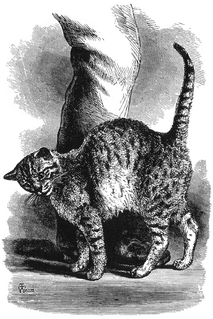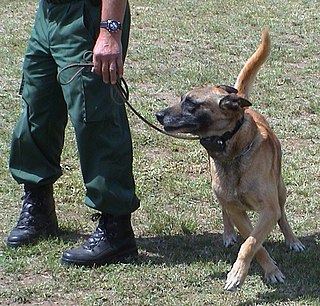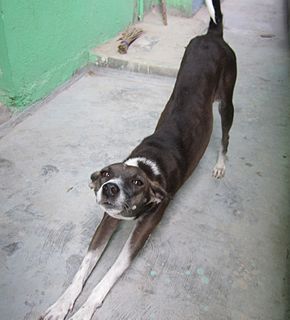Related Research Articles

A pet, or companion animal, is an animal kept primarily for a person's company or entertainment rather than as a working animal, livestock or a laboratory animal. Popular pets are often considered to have attractive appearances, intelligence and relatable personalities, but some pets may be taken in on an altruistic basis and accepted by the owner regardless of these characteristics.
Neutering, from the Latin neuter, is the removal of an animal's reproductive organ, either all of it or a considerably large part. "Neutering" is often used incorrectly to refer only to male animals, but the term actually applies to both sexes. The male-specific term is castration, while spaying is usually reserved for female animals. Colloquially, both terms are often referred to as fixing. In male horses, castrating is referred to as gelding. An animal that has not been neutered is sometimes referred to as entire or intact.
An animal control service or animal control agency is an entity charged with responding to requests for help with animals ranging from wild animals, dangerous animals, or animals in distress. An individual who works for such an entity was once known as a dog catcher, but is generally now called an animal control officer, and may be an employee or a contractor – commonly employed by a municipality, county, shire, or other subnational government area.

Cruelty to animals, also called animal abuse, animal neglect or animal cruelty, is the infliction by omission (neglect) or by commission by humans of suffering or harm upon any non-human animal. More narrowly, it can be the causing of harm or suffering for specific achievement, such as killing animals for entertainment; cruelty to animals sometimes encompasses inflicting harm or suffering as an end in itself, defined as zoosadism.

Dog training is the application of behavior analysis which uses the environmental events of antecedents and consequences to modify the dog behavior, either for it to assist in specific activities or undertake particular tasks, or for it to participate effectively in contemporary domestic life. While training dogs for specific roles dates back to Roman times at least, the training of dogs to be compatible household pets developed with suburbanization in the 1950s.

Dog aggression expressed by dogs is considered to be normal behaviour and various types of aggression are influenced by a dog's environment and genetic predisposition. Dogs commonly display possessive aggression when defending resources or themselves.

The Dobermann, or Doberman Pinscher in the United States and Canada, is a medium-large breed of domestic dog that was originally developed around 1890 by Karl Friedrich Louis Dobermann, a tax collector from Germany. The Dobermann has a long muzzle. It stands on its pads and is not usually heavy-footed. Ideally, they have an even and graceful gait. Traditionally, the ears were cropped and posted and the tail was docked. However, in some countries, these procedures are now illegal. Dobermanns have markings on the chest, paws/legs, muzzle, above the eyes, and underneath the tail.

Victoria Stilwell is an English author, dog trainer and television presenter. Stilwell has appeared as a pet behavior expert and served as a producer on several international TV series including Dogs Might Fly, Dogs With Extraordinary Jobs, and Greatest American Dog (CBS), and is best known as the star and creator of the dog training TV show It's Me or the Dog. She is a leading proponent of positive reinforcement-based dog training tools and methods to provide pet behavior advice instead of traditional methods which typically employ multiple approaches including the use of pain, fear and intimidation. She is the Editor-In-Chief of the Positively.com website, the founder and president of the Victoria Stilwell Academy for Dog Training & Behavior, the CEO of the Victoria Stilwell Positively Dog Training (VSPDT) network of dog trainers, and other dog behavior institutions. In 2017, she received an OBE for her charity work.
The dog or domestic dog, is a domesticated descendant of the wolf which is characterized by an upturning tail. The dog derived from an ancient, extinct wolf, and the modern grey wolf is the dog's nearest living relative. The dog was the first species to be domesticated, by hunter–gatherers over 15,000 years ago, before the development of agriculture.

Emotion is defined as any mental experience with high intensity and high hedonic content. The existence and nature of emotions in animals are believed to be correlated with those of humans and to have evolved from the same mechanisms. Charles Darwin was one of the first scientists to write about the subject, and his observational approach has since developed into a more robust, hypothesis-driven, scientific approach. Cognitive bias tests and learned helplessness models have shown feelings of optimism and pessimism in a wide range of species, including rats, dogs, cats, rhesus macaques, sheep, chicks, starlings, pigs, and honeybees. Jaak Panksepp played a large role in the study of animal emotion, basing his research on the neurological aspect. Mentioning seven core emotional feelings reflected through a variety of neuro-dynamic limbic emotional action systems, including seeking, fear, rage, lust, care, panic and play. Through brain stimulation and pharmacological challenges, such emotional responses can be effectively monitored.

Cat communication is the exchange of information between cats, and between cats and humans, that has an effect on their current or future behavior. They need to communicate with each other for bonding, and relating with each other; they need to collaborate, play, and share resources. When they communicate with people, they do so to get what they need: such as food.
Growling is a low, guttural vocalization produced by animals as an aggressive warning but can also be found in other contexts such as playful behaviors or mating. Different animals will use growling in specific contexts as a form of communication. In humans, low or dull rumbling noises may also be emitted when they are discontent with something or they are angry, although this human sound is often termed "groaning".

Dog behavior is the internally coordinated responses of individuals or groups of domestic dogs to internal and external stimuli. It has been shaped by millennia of contact with humans and their lifestyles. As a result of this physical and social evolution, dogs, more than any other species, have acquired the ability to understand and communicate with humans, and they are uniquely attuned in these fellow mammals. Behavioral scientists have uncovered a wide range of social-cognitive abilities in the domestic dog.

A shock collar or remote training collar is any of a family of training collars that deliver electrical stimulation of varying intensity and duration to the neck of a dog via a radio-controlled electronic device incorporated into a dog collar. Some collar models also include a tone or vibrational setting, as an alternative to or in conjunction with the shock. Others include integration with Internet mapping capabilities and GPS to locate the dog or alert an owner of his/her whereabouts.
Ian Dunbar is a veterinarian, animal behaviorist, and dog trainer. He received his veterinary degree and a Special Honours degree in Physiology & Biochemistry from the Royal Veterinary College, and a doctorate in animal behavior from the Psychology Department at UC Berkeley, where he researched the development of social hierarchies and aggression in domestic dogs.

Bite inhibition, sometimes referred to as a soft mouth, is a behavior in carnivorans whereby the animal learns to moderate the strength of its bite. It is an important factor in the socialization of pets.

A free-ranging dog is a dog that is not confined to a yard or house. Free-ranging dogs include street dogs, village dogs, stray dogs, feral dogs, etc., and may be owned or unowned. The global dog population is estimated to be 900 million, of which around 20% are regarded as owned pets and therefore restrained.

Cats and dogs have a range of interactions. The natural instincts of each species lead towards antagonistic interactions, though individual animals can have non-aggressive relationships with each other, particularly under conditions where humans have socialized non-aggressive behaviors.

Pauleen Charmayne Bennett is an Australian scientist researching anthrozoology at La Trobe University in Victoria, Australia.

Puppy cat is a term used to refer to specific breeds of domestic cats that have unusual behavioral tendencies that are reminiscent of young domestic dogs. These are within the scope of feline behavior, and may be enhanced through selective breeding. These behaviors, not specific to any breed, include following people around from room to room, the desire to receive frequent moments of physical affection such as being held and petted, a lack of aggression toward some fellow animals, and a placid nature. While these attributes are found desirable for owners interacting with their cats, problems can occur when the felines are exposed to dogs and strange people, with the cats possibly being too trusting and too friendly for their own good. Breeds known for these canine behaviors include the Abyssinian, Burmese, Maine Coon, Manx, and Ragdoll, though dog behavior traits can appear regardless of breed.
References
- ↑ "About Us, Help regarding Animal Aggression, Dog Behaviour Problems and Cat Behaviour Problems, Chorley, UK".
- ↑ "David Sands".
- ↑ "Publications".
- ↑ Archived at Ghostarchive and the Wayback Machine : Dog Attacks Dr David Sands BBC 999 series. YouTube .
- ↑ Archived at Ghostarchive and the Wayback Machine : Dog Suicide Bridge Scotland 'TV documentary'. YouTube .